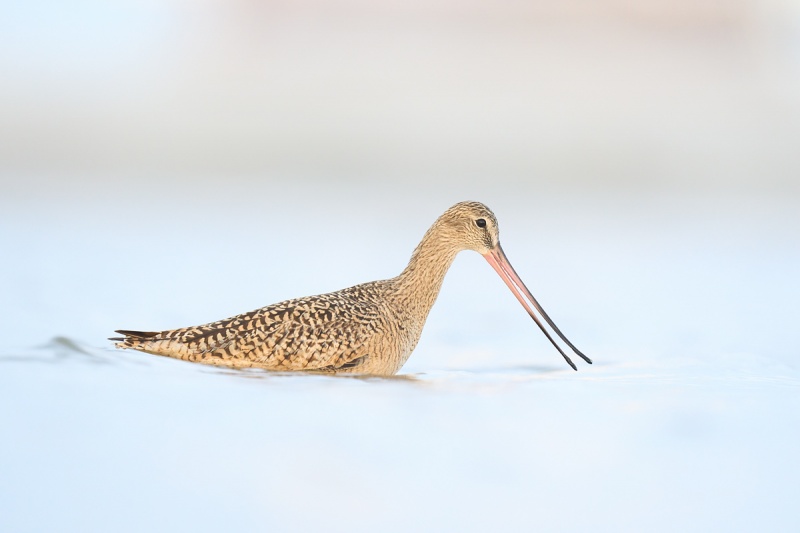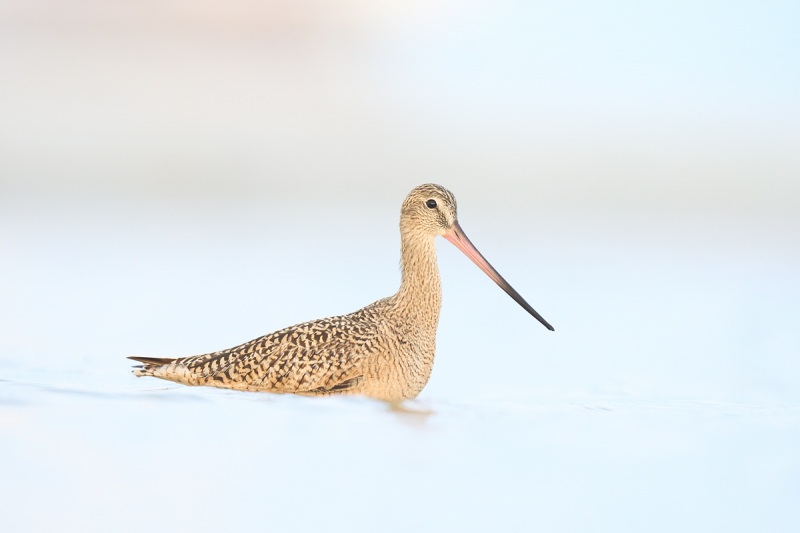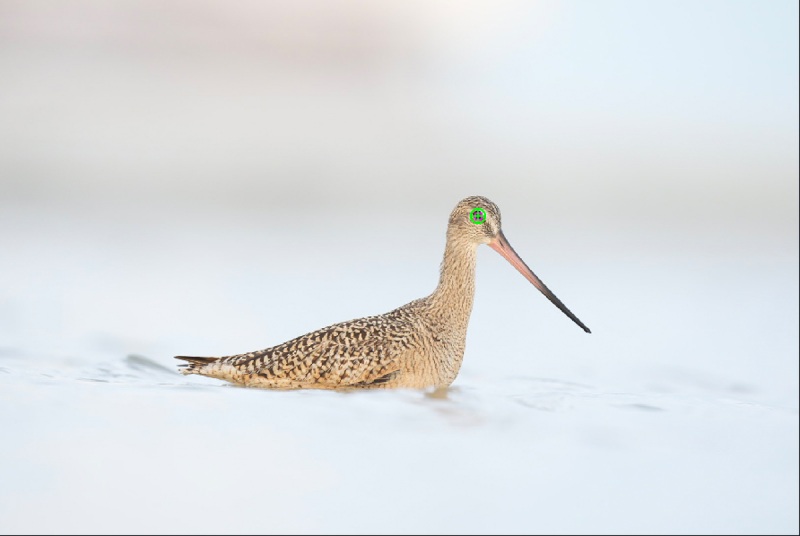A Tough Question
If you had to delete one of today’s two featured images, each admittedly superb, which one would you put in the trash? Why? Comparing the strengths and weaknesses (if any) of each image might reveal the answer. Or not. One thing is for sure, comparing the merits of these two images will be a challenge that gets you thinking.
What’s Up?
Monte Brown joined John Johnson and me on Monday morning at Fort DeSoto. Again, the weather forecast was way off, much to our benefit. The original forecast was for clear skies with northwest winds — death for bird photography. Then it changed to light rain with northwest winds — not too good for bird photography. What we got was cloudy followed by intermittent clearing with west/southwest winds. That turned out to be pretty darned good for bird photography! We had an absolutely fantastic morning.
You will be seeing lots more images from that session here fairly soon, along with the tales behind them. I am head-over-heels in love with both of today’s featured images.
On Monday afternoon, we ended the IPT a day early and drove over to ILE for a pool-deck, rib-eye steaks on the grill, big salad dinner and some more fine wine.
Today is Tuesday 13 April 2021. The three of us will be heading over to Stick Marsh early. The forecast if for perfectly clear skies with little to no wind. The three of us are very excited. Wherever you are, and whatever you are doing, I hope that you have a great day.
This blog post took about ninety minutes to prepare and makes 111 consecutive days with a new one. Please remember to use my B&H affiliate links or to save money at Bedfords by using the BIRDSASART discount code at checkout. Doing either often earns you free guides or discounts. And doing so always earns my great appreciation.
Camera User’s Guide Note
If you should have but did not receive a link to the final versions of the SONY Camera User’s e-guide or the link to the final version of the BAA R5 Camera User’s e-guide, please let us know via e-mail.
Please Remember
With income from IPTs now at zero, please, if you enjoy and learn from the blog, remember to use one of my two affiliate programs when purchasing new gear. Doing so just might make it possible for me to avoid having to try to get a job as a Walmart greeter and will not cost you a single penny more. And if you use Bedfords and remember to enter the BIRDSASART code at checkout, you will save 3% on every order and enjoy free second-day air shipping. In these crazy times — I am out at least forty to sixty thousand dollars so far due to COVID 19 (with lots more to come) — remembering to use my B&H link or to shop at Bedfords will help me out a ton and be greatly appreciated. Overseas folks who cannot order from the US because of import fees, duties, and taxes, are invited to help out by clicking here to leave a blog thank you gift if they see fit.
New and Better Bedfords Discount Policy!
You can now save 3% on all of your Bedfords photo gear purchases by entering the BIRDSASART coupon code at checkout. Your discount will be applied to your pre-tax total. In addition, by using the code you will get 2nd day air shipping via Fed Ex.
Grab a Nikon AF-S Teleconverter TC-14E III and save $14.99. Purchase a Canon EOS R5 and your discount will be $116.97. Purchase a Sony FE 600mm f/4 GM OSS lens and save a remarkable $389.94! Your Bedford’s purchase no longer needs to be greater than $1,000.00 for you to receive a discount. The more you spend, the more you save.
Money Saving Reminder
Many have learned that if you need a hot photo item that is out of stock at B&H and would enjoy free second-day air shipping, your best bet is to click here, place an order with Bedfords, and enter the coupon code BIRDSASART at checkout. If an item is out of stock, contact Steve Elkins via e-mail or on his cell phone at (479) 381-2592 (Central time). Be sure to mention the BIRDSASART coupon code and use it for your online order to save 3% and enjoy free 2nd-day air shipping. Steve has been great at getting folks the hot items that are out of stock at B&H and everywhere else. The wait lists at the big stores can be a year or longer for the hard to get items. Steve will surely get you your gear long before that. For the past year, he has been helping BAA Blog folks get their hands on items like the SONY a9 ii, the SONY 200-600 G OSS lens, the Canon EOS R5, the Canon RF 100-500mm lens, and the Nikon 500mm PF. Steve is personable, helpful, and eager to please.


Gear Questions and Advice
Too many folks attending BAA IPTs (remember those?) and dozens of photographers whom I see in the field and on BPN, are–out of ignorance–using the wrong gear especially when it comes to tripods and more especially, tripod heads… Please know that I am always glad to answer your gear questions via e-mail. Those questions might deal with systems, camera bodies, accessories, and/or lens choices and decisions.
|
|
|
This image was created on 12 April 2021 on the first DeSoto IPT. I used the Sony FE 600mm f/4 GM OSS lens (with the lens foot resting on the ground) and The One, the Sony Alpha 1 Mirrorless digital camera. ISO 2500. Exposure determined via Zebras with ISO on the rear dial: 1/500 sec. at f/4.5 (stopped down 1/3-stop; should have been wide open) in Manual mode. AWB at 7:36:56am on a still, cloudy morning. Wide/AF-C was active at the moment of exposure and performed perfectly. Click on the image to see a larger version. Image #1: Marbled Godwit foraging while swimming |
Enthralled With the Super-low Perspectives …
I have always loved getting down and dirty and flat on my stomach photographing shorebirds. With age, getting down is not too bad; getting up is a bit harder. Arching ones back is a problem for some including me. For today’s two featured images, created while I was seated on the wet sand, I placed the lens foot on the ground and tilted out the rear screen. This afforded me the super-low perspective that I love so dearly. Without having to lie down in the wet sand.
|
|
|
This image was created on 12 April 2021 on the first DeSoto IPT. I used the Sony FE 600mm f/4 GM OSS lens (with the lens foot resting on the ground) and The One, the Sony Alpha 1 Mirrorless digital camera. ISO 2500. Exposure determined via Zebras with ISO on the rear dial: 1/500 sec. at f/4.5 (stopped down 1/3-stop; should have been wide open) in Manual mode. AWB at 7:36:58am on a still, cloudy morning. Wide/AF-C was active at the moment of exposure and performed perfectly. Click on the image to see a larger version. Image #2: Marbled Godwit swimming |
The Plusses and Minuses of Using the Rear Screen at Ground Level …
The Plusses
- 1- The super-low perspective produces creamy/dreamy backgrounds (especially at f/4!)
- 2- Photographs created at the subject’s eye level are decidedly more intimate than images made from higher perspectives.
The Minuses
- 1- Even with the level on the rear screen active and your reading glasses on (mine were safely in the car when I made this image), it is a challenge for most folks to level the image. And when you are panning along with a moving subject, keeping the image level even more of a challenge. Next time I will bring my Panning Ground Pod.
- 2- Without having your eye to the viewfinder, you are working somewhat blind. It is difficult to determine the subject-to-sensor-plane orientation and even more difficult to note the head angle.
- 3- Simply finding the subject is far more difficult than it is when working through the viewfinder, and once you find the bird with your long lens, framing it properly can be a huge challenge. Both of today’s images needed small crops for the rear (and from above and/or below), to move the bird back a bit in the frame.
- 4-Again, without your eye to the viewfinder, you must have complete faith in your camera body’s AF system. If it does not perform, all of your effort will be for naught. Note: when looking through the viewfinder, you can see the AF point or points at work … That is not the case when using the rear screen.
5- You will get sand on your lens, the lens foot, the lens hood, and on you camera body. (The same would be true if you were lying prone, flat on your belly, looking through the viewfinder …) That is why you always have a soft paintbrush with you in the field.
So what is the solution? Do your best and make lots of images; the shotgun approach can yield amazingly beautiful dividends (as it did in this situation). And the Sony Alpha 1 Mirrorless digital camera’s 30 frames per second Drive Mode is a huge plus in pretty much all situations where the subject is moving.
Note: though there were two godwits swimming along, I am sure — based on some distinctive plumage markings — that the bird in both images is the same individual.
|
|
Image #2A: AF Point for one of the Marbled Godwit swimming images |
What Can I Say?
My faith in the AF system (set up properly as detailed in the SONY Alpha a1 Set-up and Info Group e-Mail #1), was completely justified as it nailed the focus in every frame of the 76-image sequence.
Sony Alpha a1 AF Magic …
The AF system of the a1 — set up as detailed in e-mails to the Sony Alpha a1 Info & Updates group, continues to amaze me. Early on, there was lots of discussion within the group with many preferring multiple back button approaches. For me a simple shutter button approach with the right AF settings that yield 99% sharp-on-the-eye images is best. By far. It is super-simple and mega-effective. Note: info on the program that I use to ascertain SONY AF point information is detailed in one of the SONY Alpha a1 Set-up and Info Group e-mails. I plan on making that information available here soon for all SONY camera users. You guessed it; I am working on a guide. 🙂
SONY Alpha a1 Set-up and Info Group
The SONY Alpha a1 Set-up and Info Group is going great guns as folks chime in with thoughtful questions and experience-based advice. We are now up to an astounding 35 folks. Early on, we discussed the myriad AF options. I gave my opinion as to the best one for flight and general bird photography. More recently, we have been in contact with folks at SONY sharing our thoughts, experiences, and frustrations with the EVF blackout problem.
All who purchased their Alpha a1 bodies via a BAA affiliate link will receive a free subscription to the Sony Alpha a1 Set-Up and Info Updates after shooting me their receipts via e-mail. This same service may be purchased by anyone with an a1 body via a $150.00 PayPal sent to birdsasart@verizon.net indicating payment for Alpha a1 Info Updates. Alternatively, they can call Jim weekday afternoons at 1-863-692-0906 to pay via credit card. New members will receive composite e-mails that summarize all previous discussions.
The Fort DeSoto Site Guide
Though a bit long in the tooth (like me), the Fort DeSoto Site Guide will get you to my two favorite morning spots. John Johnson and I killed at DeSoto for three straight mornings.
Typos
With all blog posts, feel free to e-mail or to leave a comment regarding any typos or errors.


















I like image #2 better but I have to say I don’t love either one. I prefer some background to give the shot context and place the subject in its environment. Here, the bird just seems to be floating in milk or something.
1 is more interesting, 2 is more beautiful. Call me superficial, but I’ll take beautiful!
Hi, Artie. Why trash either? But I prefer #1, largely for the open bill. By the way, I cut some of my photographic teeth on a twin-lens reflex camera, which had some of the issues you describe with the tilt screen.
Yashica, Mamiya, or Rollie?
I would keep No. 1. I prefer the position of the head and the open bill. The line created from the tail to the head moves my eye through the image and the open bill adds a sense of movement in the photo. Like others have said before I would keep both images.
Great situation (swimming in heaven, indeed!) and images. I strongly prefer #1 for the action, the flexed bill, and the more interesting water, but I often prefer images where the bird is doing its own thing, seemingly not concerned with the camera, head angle or not.
No deletes here!!! I like the beak and water movement in #1. I really like the posture and slightly better head angle in #2. I think I favor #1 ever so slightly. Be head over heels happy with these! They deserve it and you earned it. Thanks for sharing, we all love it and appreciate it. Steaks win out over In-N-Out but they’re a close second!
I have to go with image #2 because there is that immediate connection with the subject when the eye of the Whimbrel is looking back at the camera with the head at a 5 to 10 degree angle.
I was also slightly distracted by the wave action in image #1but that is only a personal thought.
Bottom line is that both are keepers for most of us.
If I made those images, I wouldn’t delete either. They are both keepers.
I like both of these Artie! #1 because of “sipping” and #2 because of sort of looking at “me”!! HaHa!! Great colors and great focus and great spots.
For me, No 1. The little curve of the wave matches the profile of the subject, thus the bird and the movement of the water blend in harmony with one another.
I feel the first is more interesting but the second more intimate with the better engaging head angle. If I could only keep one it would be #1.
I was confused by your comment in point #4 when you said via the rear screen you can’t see the AF points like you can through the viewfinder. I see the exact same AF points overplayed and dancing around on both my LCD and EVF. Maybe I’m missing the point you were getting at but you should be able to see what the AF points are doing on the LCD. Unless you were just referring to not having your glasses with you.
overplayed should read overlaid…
Thanks, Geoff. I cannot see the rear screen from 1 1/2 to two feet away even with my reading glasses … So, yes, the points are dancing; I just cannot see them from a distance. Getting old, however, is way better than dying 🙂
with love, a
Howdy Artie
I love both images but in looking at both the head angle in #2 is about the 2 degrees that you always speak of and not seeing much in the soft waves, image #1 i love the feeding aspect and the soft waves even though the head angle isn’t looking at us it shouldn’t be as it feeds along.
If i was forced to delete one it would be #2, image #1 just pops more when i look at it and the browns pop more. I will keep #1 as it holds my eye longer!
Thanks for the thinking lesson
Always with love b
Both really nice. While I believe the head angle on image 2 is better, I prefer image one because I like seeing the open bill. It adds to the story of the foraging behavior.
I like the open beak and little wave on image #1.
I really love both of the images, Artie. The angle of the bird’s head in image #2 really draws me in and makes it the perfect portrait but the tiny wave at the rear of bird #1 along with his open beak make it a more interesting image for me. The longer I look at the two images, I prefer #1.
The head on #1 is slightly tilted away! #2 wins with head position! Both are heavenly!
Both great images, but for me, Image 2, simply for the head angle…..